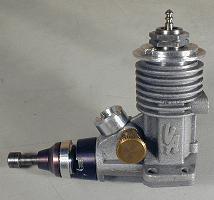
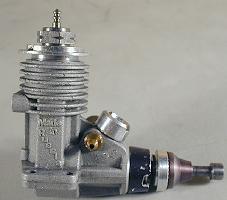
The VA 049 Mk 1. This engine is serial number 109. This example is fitted with the optional head and Nelson plug.
VA engines resulted from a design exercise at the St. Petersburg Polytechnic in Russia.

 |
|
The VA 049 Mk 1. This engine is serial number 109. This example is fitted with the optional head and Nelson plug. |
The Mk 1 was equivalent to a Cox TeeDee 051 but was 4 grams lighter at 42.5g and may have been a little more powerful. It was designed as a drop-in replacement for the TeeDee, so it used TeeDee glow heads and fitted onto bearers that had been spaced and drilled for a TeeDee. Like most Russian engines, it preferred smaller props than the TeeDee. Best performance was obtained with props in the 5 to 5.5 inch range and pitches that let it wind up fast.
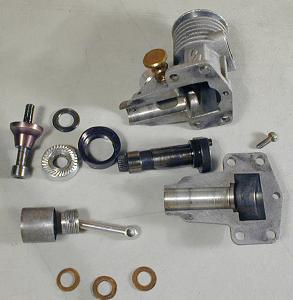 |
|
|
Clockwise from the left: the VA 049 Mk 1 disassembled, rear view showing the screw securing the halves of the case, side view showing how the crank case is split. |
The engineering was unusual in many respects.
The cylinder used sleeveless AAC technology with the chrome plated onto a bore machined directly in the top casting. The sand cast case was split horizontally through the mounting lugs and main bearing to allow the chrome cylinder lining to be honed to the correct taper from below. The two halves were held together by a vertical rear screw, a black anodised alloy front ring and the engine mounting bolts. The mounting bolts form an integral part of the engine's structure: it should not be run without all four bolts in place and tight. Some owners thought that the upper case to lower case fit was not tight enough and was likely to leak so they fitted gaskets made from liquid silicone.
Although the engine was designed for the Cox TeeDee glow head, it could also be fitted with GloBee buttons and clamp rings or and optional alloy head that was tapped for a Nelson plug. All top ends screwed into the upper crank case casting and seated on shims that could be changed to adjust the compression ratio.
The piston was screwed onto the piston carrier, which contained the gudgeon pin. Shims, which were supplied in several thicknesses, were placed between the two to alter the engine timing by raising and lowering the piston relative to the piston carrier and hence to the exhaust and transfer ports. Care had to be taken to avoid adding so many shims that the piston hit the plug. If it did, the situation could be recovered by removing shims from the piston or adding more head shims: the latter were used to change the compression ratio once the timing had been set by shimming the piston. The combinations were infinite. The use of Loctite or equivalent to hold the piston in place on the carrier once the timing was satisfactory was recommended but, with the heat involved, most locking compounds would fail. In any case as it was difficult to know when the timing was right, many people avoided the use of locking compounds. Setting up the engine was a very slow process since it had to be taken apart each time to make a change in timing, which in turn affected the compression setting. In the USA, the importer supplied a thick set of instructions on how to change timings and compression, though many owners just sent their engines off to a specialist engine tuner.
Early engines had a problem with breaking the pin off the crankshaft but this was quickly fixed by heat treating the part. This same problem affected the TeeDee engines and the solution was the same. Set the kitchen oven to its maximum temperature and put the crankshaft in it. Hold the oven at its maximum temperature for an hour, and then turn it right down and let it cool slowly.
The standard Cox TeeDee multi-wrench tool could be modified to remove the head as well as the front collar.
Information about the VA 049 Mk 1 came from Hank Nystrom of Texas Timers who also supplied all the pictures, which are of his engine. Thanks also to John Bailey for pointing out that the engine was designed as a Cox TeeDee replacement.
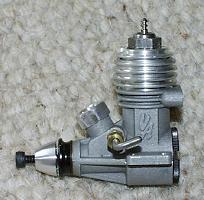 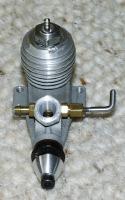 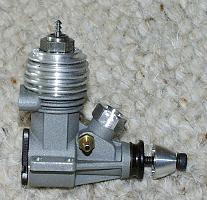 |
|
The VA 049 Mk 2. This example has a Nelson plug adaptor installed. |
The Mk 2 was completely different to the Mk 1. It was built conventionally for this type of engine apart from the two piece piston, which was similar to that used previously. It was a rear exhaust, plain bearing engine with a single piece sand cast crank case. This crankcase was more robust than that of the Mk 1 and, although the mounting bolts still matched the original spacing, the crankcase was too wide to fit between bearers spaced for a Cox TeeDee 051. The mounting lugs were rather narrow in consequence. The Mk 2 was an AAC technology engine with a separate machined and chromed cylinder barrel retained in the crank case by a screw-in head clamp. A black anodised back plate screwed into the crank case. It was supplied with a special button plug that was retained by the head clamp. A Nelson plug adaptor was also available. This version weighs 44.3g with a Nelson plug and adapter fitted, so it is still a little lighter than a Cox TeeDee 051.
The late George Aldrich described it as follows:
I have just received the new VA Mk. II .049, and it is LIGHT YEARS better than the old Mk. I. It's advertised in the latest Flying Models. It still has the adjustable piston/timing feature and the one I received had timing for C.L. Combat. I would advise ordering it with the piston Loctited and the timing set for 150 deg. of exhaust timing, as the 160 deg. mine had is too high for our prop sizes. These engines aren't designed to EVER swing a 6 x 3, but really come alive on a 5.5 x 2, or 5.5 x 2.5 ! The quality rivals that of a Shuriken on this new engine ! At $69.95, it a "keeper" !
The engine's US importer is Larry Driskill.